COVID19: What’s in store for Commercial Real Estate?
19 min read

19 min read

In a matter of weeks, the lives of so many have been impacted by tectonic shifts caused by the Covid-19 pandemic. People stopped meeting, working, eating, shopping, and socializing the way they once used to. The world of work shifted swiftly from doing business as usual to diminishing, if not entirely avoiding, business travel, closing offices, and adapting to the work-from-home lifestyle.
Rather than spending their money on dining out and traveling, consumers across the globe started tightening their purse strings and limiting their expenses only on what they consider to be essentials. Aside from spending less, even when they are spending, they turn to home delivery much more often now, too.
Let’s take online shopping as an example and show how big the change was in the area, all driven by the coronavirus pandemic and its knock-on effects.
One of the main consumer habits is online shopping. Online shopping wasn’t introduced in 2020, it was already here before it. However, the coronavirus pandemic did make more consumers than ever shop using a click of their mouse or a tap on their screen. As a matter of fact, online sales represented roughly 20% of all retail purchases at the end of 2020, which marked an astonishing 7% increase from a year earlier. And, while there are many people who are impatient to go back to browsing sales racks in person again, a group of analysts agrees that the way we shop has changed for good.
And while the 7% increase may not look that significant at the first glance, it is certain that the transition from bricks to clicks will have massive implications in store for CRE. For instance, investors and lenders will most likely place more value on brick-and-mortar locations that offer drive-throughs and curbside pick-ups, meanwhile cold storage units will be valuable thanks to the rise of online grocery shopping.
The need to keep physical distance on a daily basis has directly changed the way people not only interact among themselves but also the way they inhabit and interact the physical space, which, in turn, made the demand for numerous types of space go down, perhaps for the first time in modern memory. All of these tectonic shifts have had a gruesome effect on the real estate industry and have quite literally shown everyone that this unprecedented crisis is an unprecedented challenge, but not only, since the longer it lasts, the more likely we are to keep seeing transformative and long-lasting changes in behavior.
The real estate leaders must take action and make a game plan on how to respond to the ongoing, urgent threat of the coronavirus pandemic. They need to lay the groundwork and work on finding strategies to deal with what could very well be permanent changes for the industry even when we wave goodbye to Covid-19.
Over the past few years, all the investments in real estate have generated both steady cash flow and returns that are outstandingly above the traditional sources of yield. The coronavirus outbreak put a halt on this prolific business and the real estate players have taken a huge hit across the value chain. Service providers are grappling to keep their customers and employees safe and healthy. While asset owners and operators are facing a drastically reduced income, worried about the number of tenants that will be able to make their lease payments on time, developers are running into roadblocks when trying to obtain permits and are facing construction delays and stoppages and even shrinking rates of return.
Not all real estate assets have been hit the same way and with the same intensity during this ongoing crisis. The market has apparently pivoted mostly on the degree of physical proximity among an asset and its users, rather than on its lease length. In addition, assets that were designed for greater human density, seem to have been at the epicenter of the crisis. All the shopping malls, lodging, student housing have been largely impacted by extensive lockdowns and similar measures that many states introduced in order to limit the spread. On the contrary, self-storage facilities, data centers, and industrial facilities have seen less significant declines in demand. It’s no news that once shoppers start avoiding crowds, universities shift to the digital world, and retailers, restaurants, and hotels shut their doors – the owners and operators of such properties are not in an enviable position.
Real estate is the largest illiquid asset class in the world. And this is two-fold as it was estimated at over $228 trillion in asset value in 2016 but the number of people employed either directly or indirectly in the industry sets it apart from the rest, too. That’s exactly why governments around the world, at the deferral, state, provincial, and even municipal levels are focusing on Covid-19 financial support for the sector. The type of response varied considerably, some turned to indirect support, such as deferrals of rent and changes of eviction rules, while others turned to provide direct financial support of landlords. One thing is clear, governments did recognize that stimulus plans were required in order to maintain stability throughout the course of the coronavirus pandemic. The problem goes deep and shies away from dealing with it puts the tenants, landlords, building value, property taxes, safety and security, and quality of life in every community at risk.
In order to understand the scale of Covid-19 impact on CRE, let’s look back at other external shocks that happened over the past century and have inevitably had an immediate to short-term effect on CRE asset prices, but not as significant influence on transaction activity. The CRE industry, however, managed to recover from all these events at different paces. For instance, while event-oriented downturns showed a quicker recovery, longer-term events, such as the 2008 recession, resulted in a long rebound.
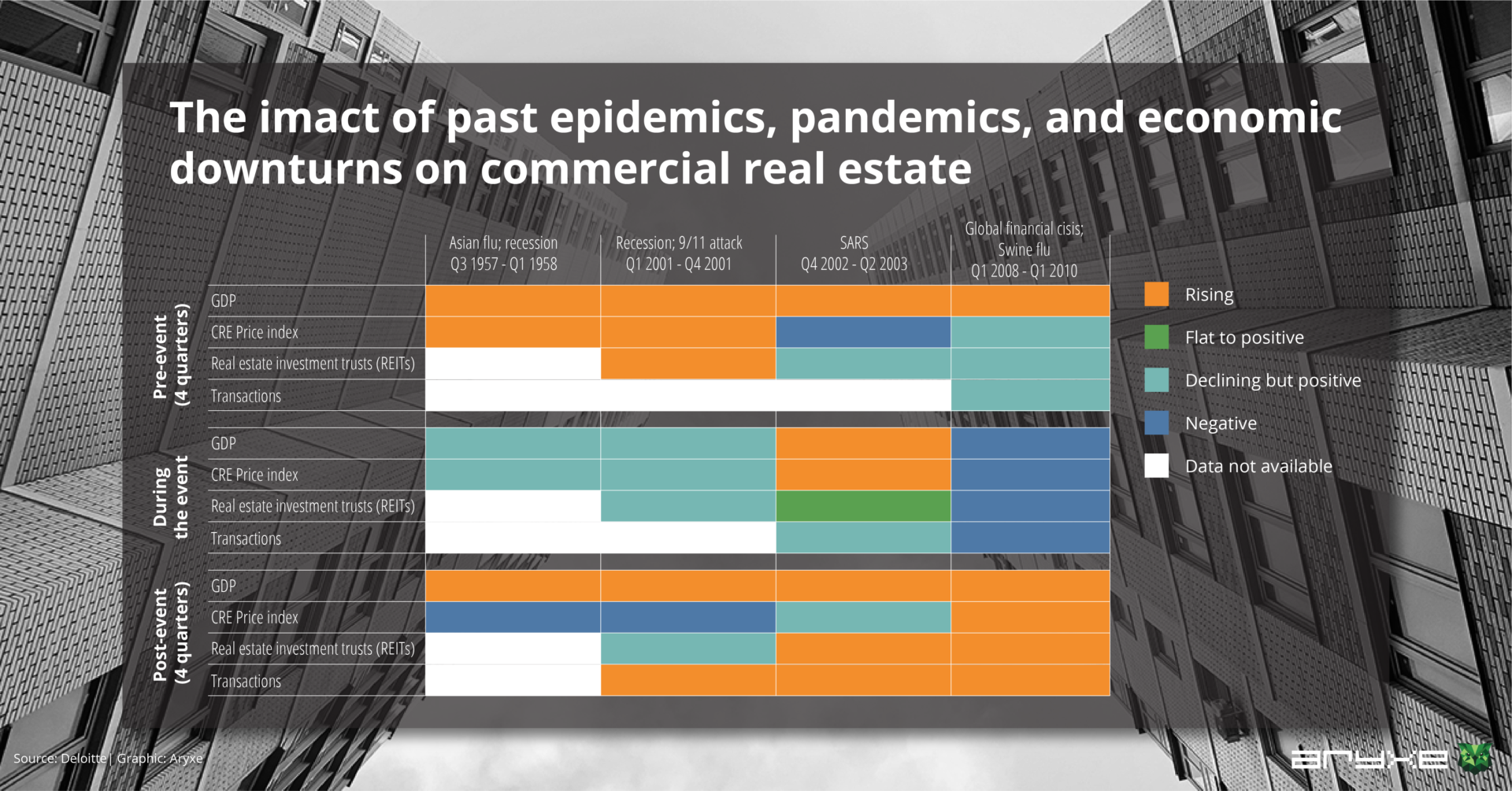
In contrast to the 2008 recession-driven downturn, the Commercial Real Estate industry was in a fairly stable position before the Covid-19 outbreak took over the world. Capital availability, balance sheets, liquidity – everything was looking healthy.
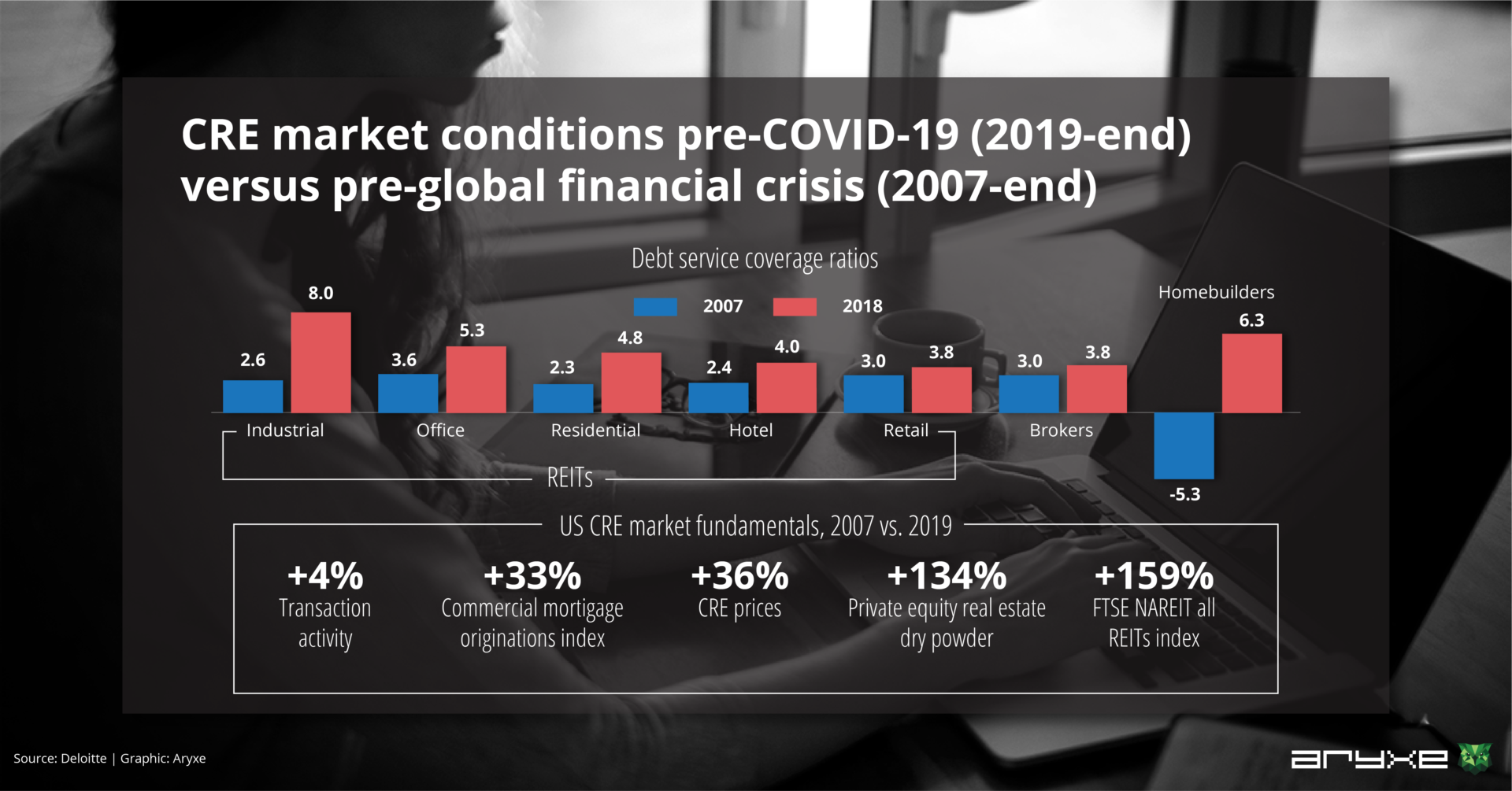
Starting from the second week of March 2020, once Covid-19 has officially been declared a pandemic, financial markets, across the US, started their sharp decline. The S&P 500 and Russel 2000 plunged by an astonishing 13% and 29% YTD as of April 2020, while the US 10-year treasury years dropped by 127 bp to 0.6% over the same period. So, rather than the typical lag, the Commercial Real Estate Industry ended up being affected immediately by the newly declared pandemic and this was driven by the trade activities and occupiers’ businesses being shut down.
Lending
The keyword here is cautiousness. Although markets remained fairly accessible, due to the enhanced risk, most lenders were operating with increased caution.
Liquidity
Certain property owners had to deal with short-term liquidity management issues, solely because of delays in rent collection and increased costs. Looking at shopping centers’ REITs as an example, they received only 46% of their typical rent in the first few weeks of April.
Leasing
Certain submarkets witnessed a 25% drop in leasing volumes YoY, which was the lowest since 2013.
Operations
Social distancing and government directives reverberated through the closures of most hotels, malls, shops, offices, and even co-working and living spaces. Another significant impact on operations stability was an enhanced focus on sanitation, cleaning, security, and thermal checkpoints, which in turn meant having higher operational costs.
One of the main questions posed rather frequently, especially at the outset of the pandemic, was the question of the pandemic’s impact on tenants’ businesses.
With REITs, there have been different types of impact based on different property types, the scale of the Covid-19 influence on tenant businesses. The Data Center REITs index was thriving YoY in the 1st quarter of 2020, while the retail and hotel REIT index plunged 48% and 53%. One thing that softens the blow for their REITs is the long-term lease contracts they normally have. But, leases associated with the highly-impacted segments immediately felt pressure because of their reliance on tenant business and liquidity.
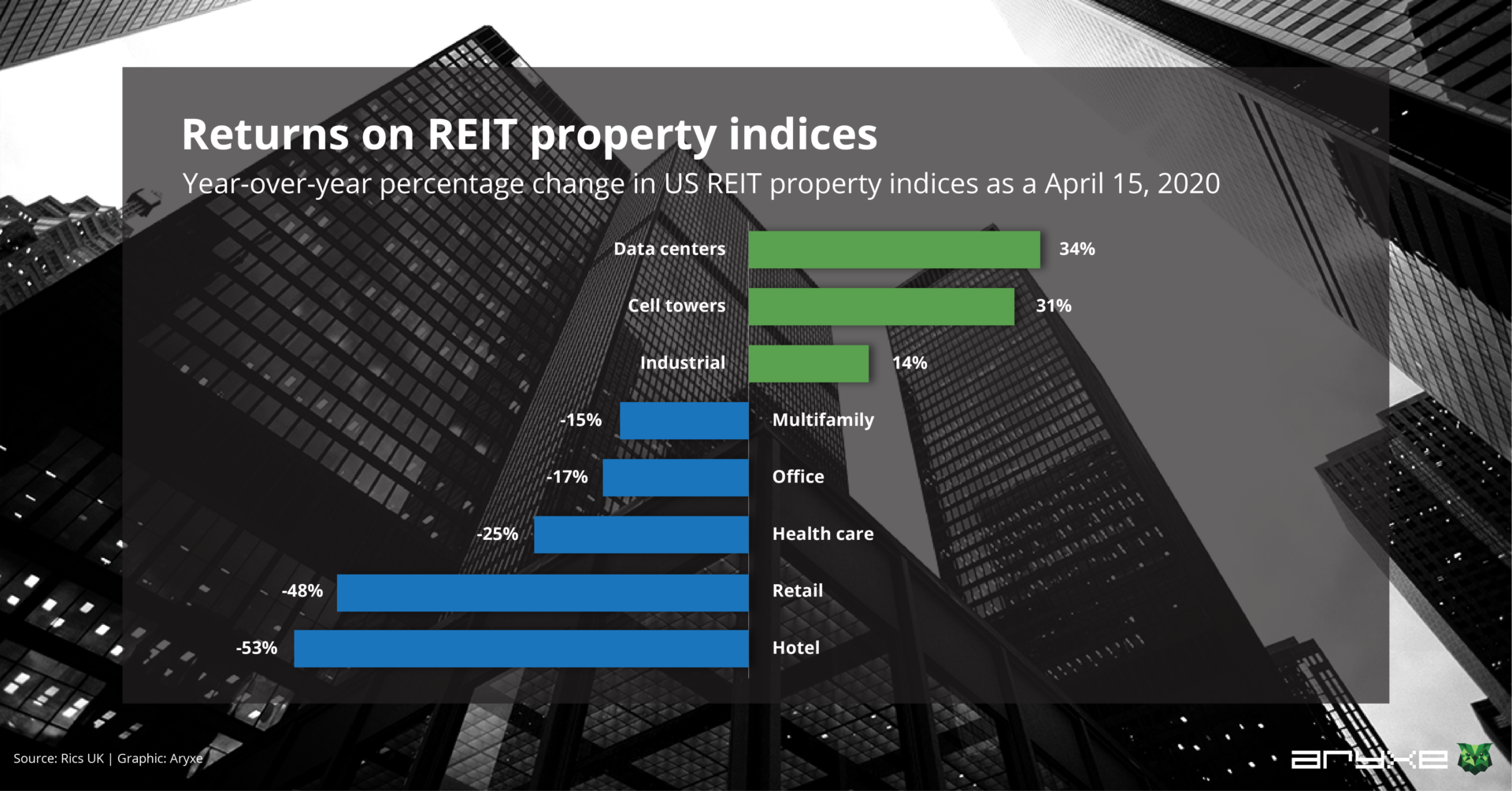
There is an obvious dichotomy in operating fundamentals among different property types. While industrial real estate, health care, data centers, and cell towers are seeing a positive disruption, hotels, offices, and retail are the ones feeling the negative effects of the ongoing health crisis.
And, according to the RICS research published in December 2020, the United Kingdom, as well as the United States, is showing signs of sustained recovery. In fact, they see Brexit and coronavirus as the push towards a new world, marked by the benefit of growth in advanced tech. Data centers and warehousing are the new real estate sectors that will drive the demand. Industrial and residential demand might follow the tech strength but prospects are way gloomier for office spaces and retail. Both are in the midst of changing patterns of consumption and work. Let’s take a closer look at their research results, focusing on Occupier Demand, Availability, Rent Expectations, and last but not least, Investment Options.
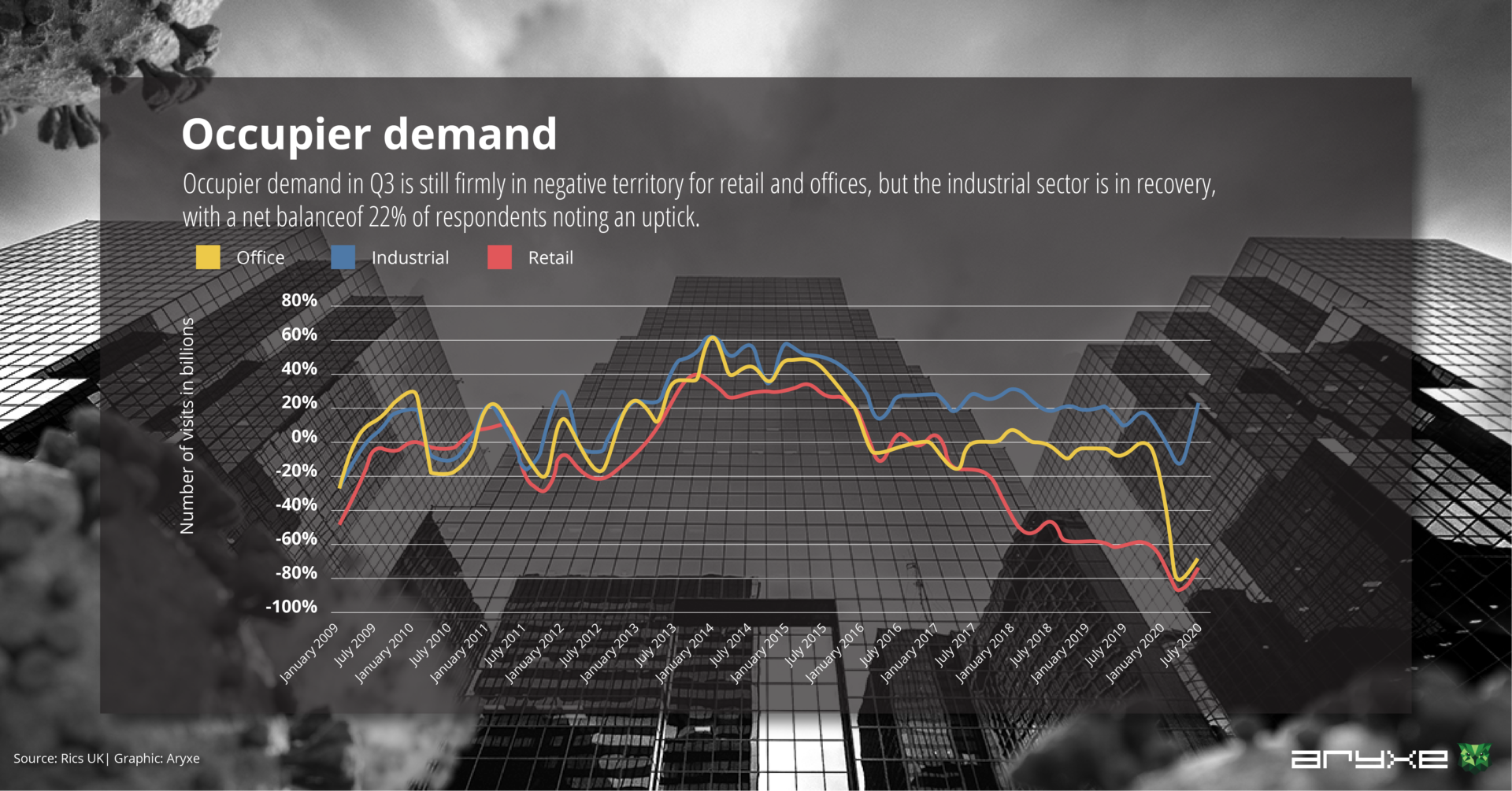
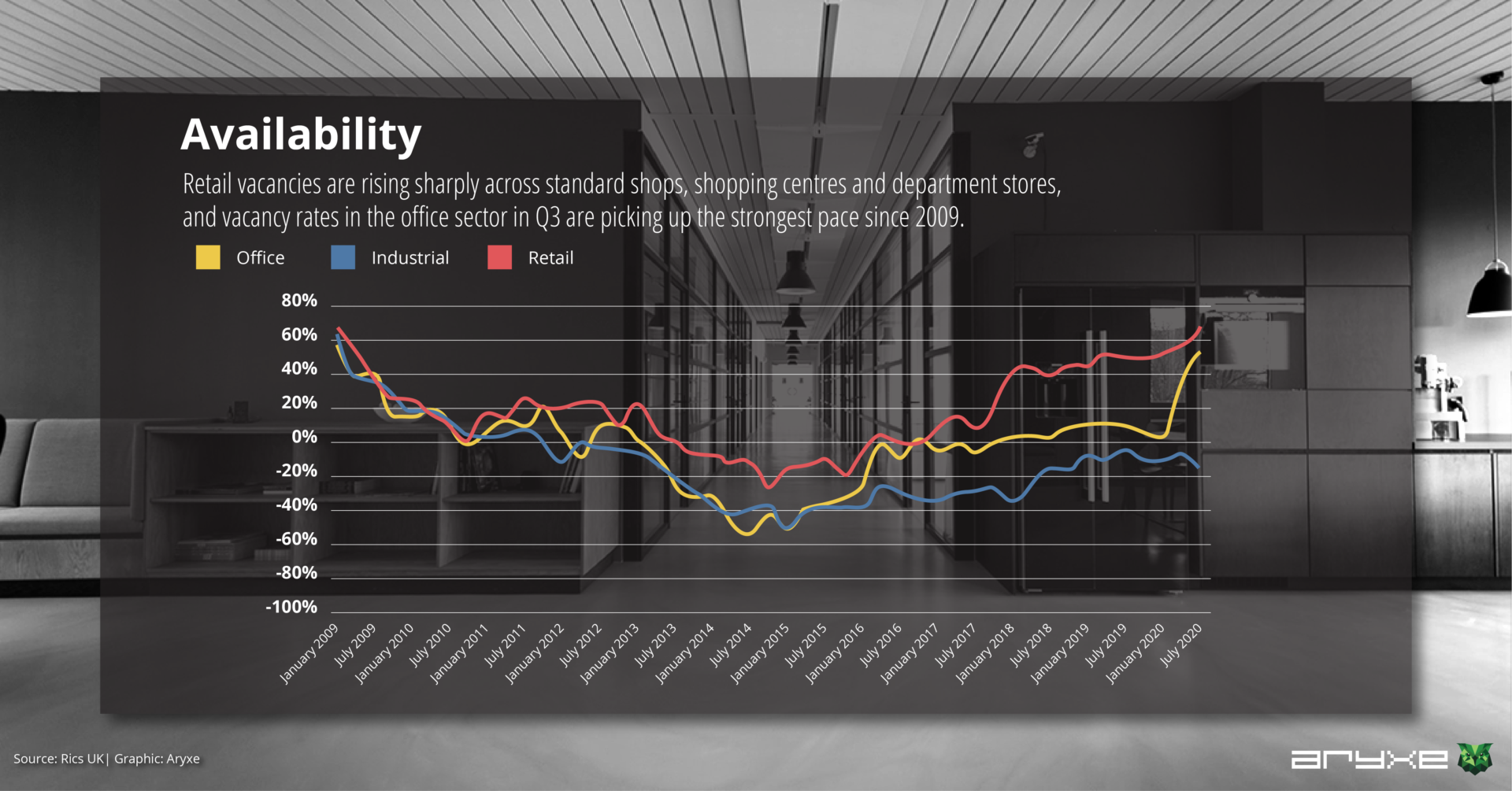
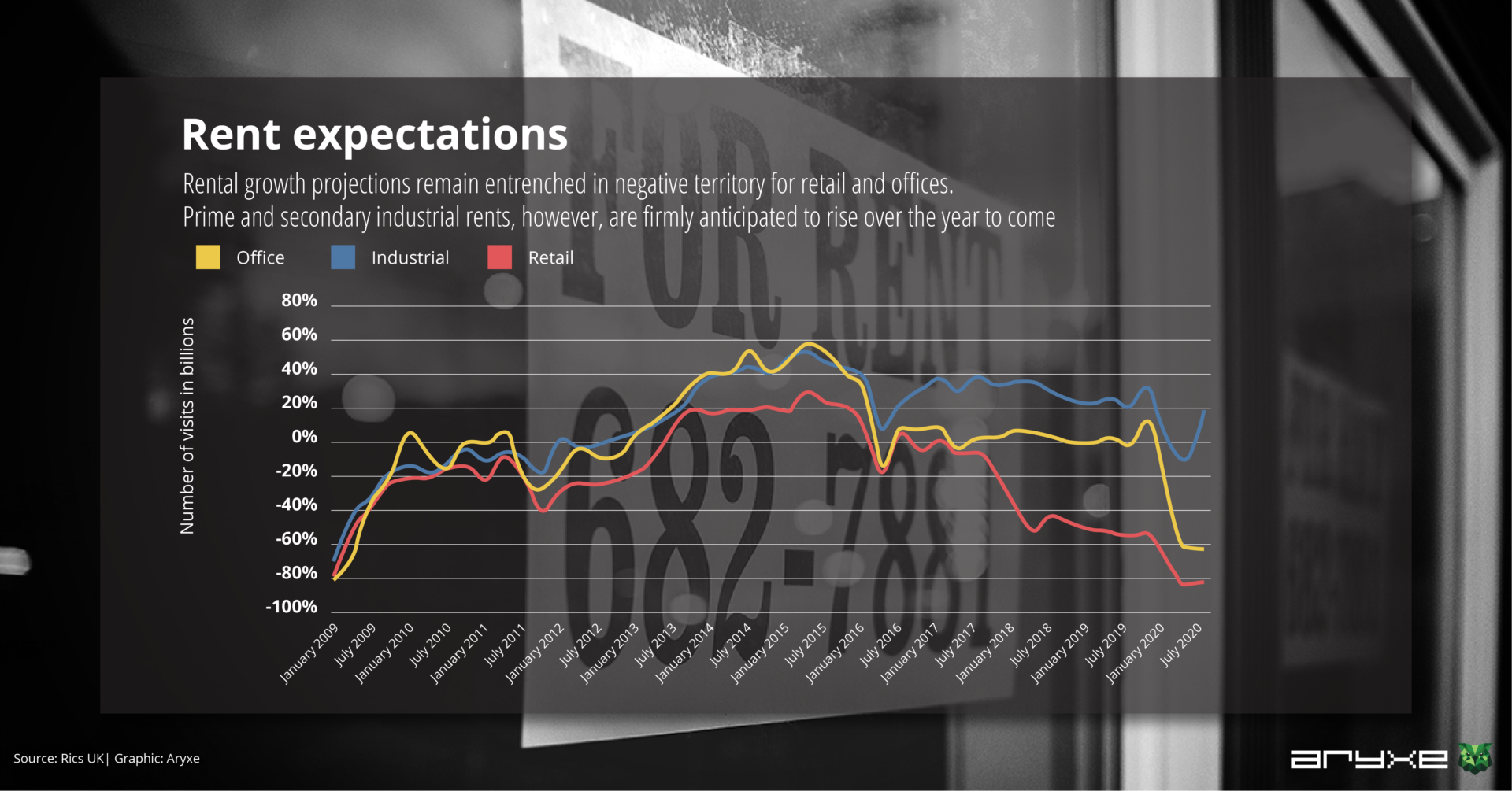
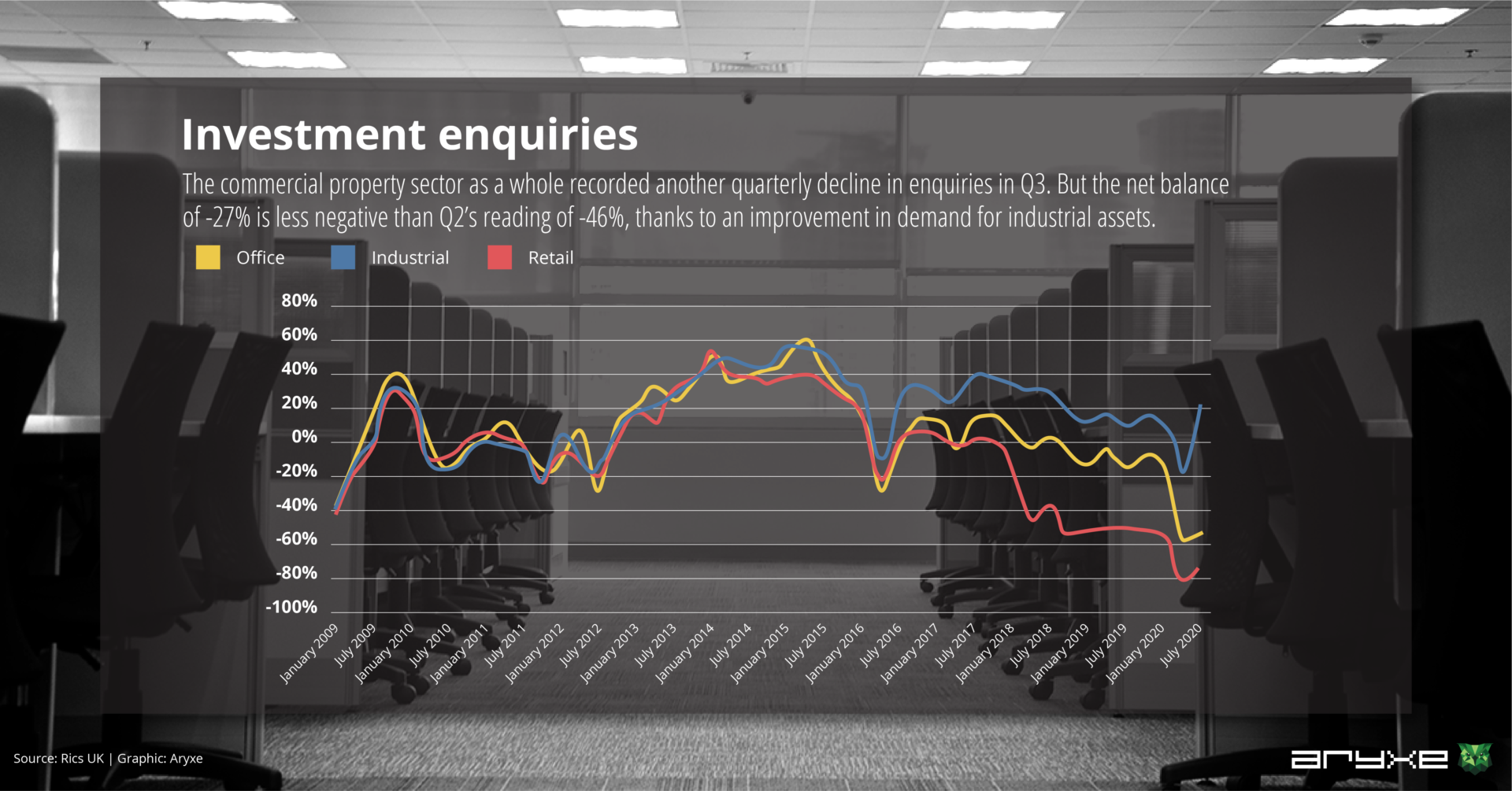
Deloitte’s research shows that Global Commercial Real Estate deal volume dropped 36% YoY due to economic stagnation and an unstable pricing environment. In the US, retail and office price indices dropped 4.1% and 0.5% YoY in August 2020. But unlike retail and offices, the industrial property index rose 7.4% YoY. Deloitte surveyed over 200 CRE senior executives, in an attempt to find out how prepared they are to navigate the current economic situation, what are their mitigation strategies going to be over the next 12 months, and what is their game plan when it comes to maintaining their level of competitiveness on the long run. Most responders agree that their companies were not prepared in certain areas and tend to align on the common struggle when it comes to tweaking their long-term strategies. Here are some notables:
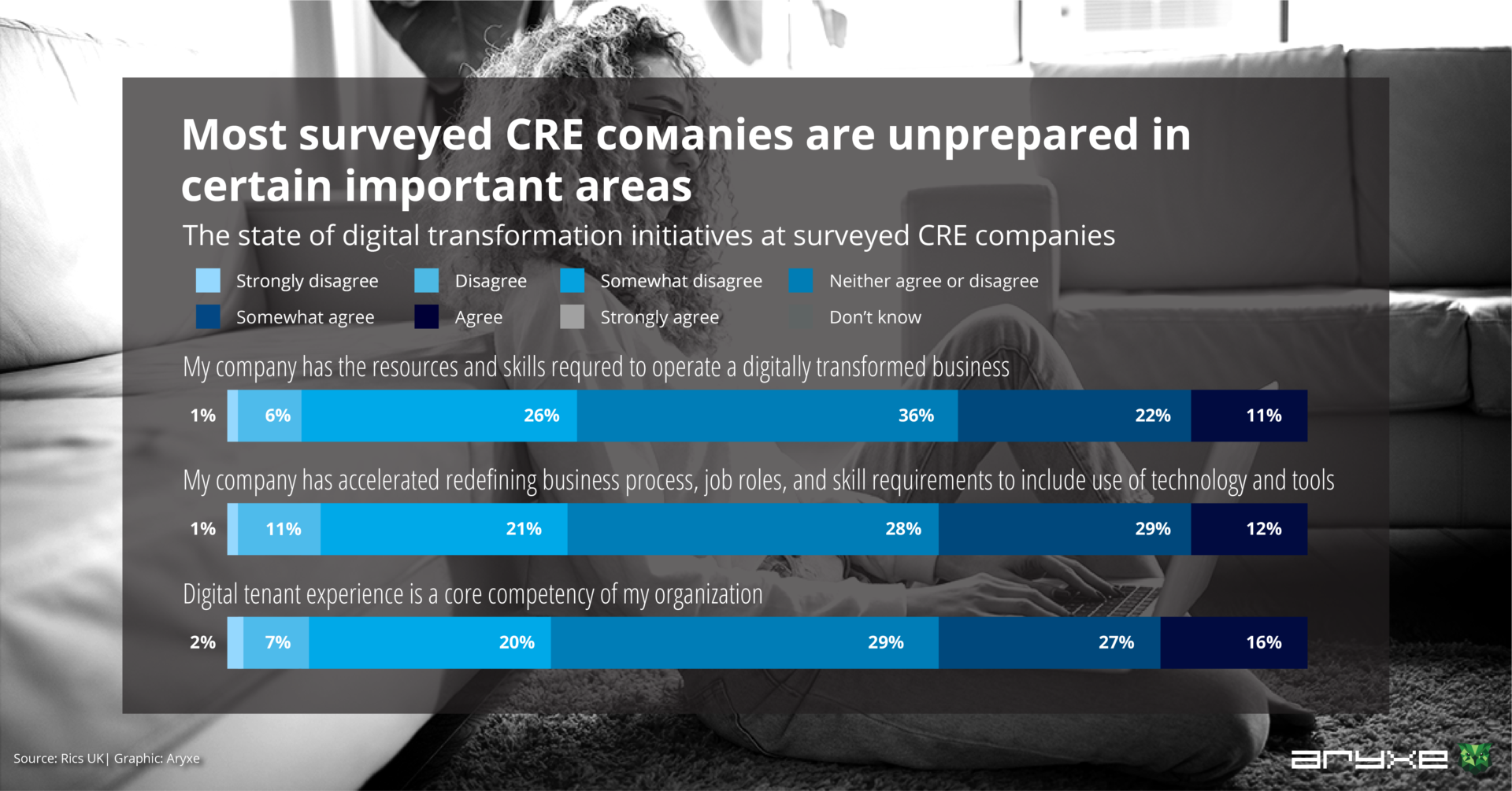
The coronavirus pandemic has switched gears when it comes to the use of technology in the Commercial Real Estate industry. In a matter of just a few weeks, the majority of the CRE workforce moved to working from home, giving property tours virtually, and transferring most tenant communication to online channels. This goes hand in hand with them relying on technology in order to manage day-to-day operations. Some of them even increased their use of cloud-based collaboration and employed productivity tools so that they could lower in-house tech costs and increase flexibility.
While these innovations in the CRE world may help improve tenant convenience and vouch for the continuance of business, CRE companies find it hard to define digital workflows and processes. Most of the survey respondents (56%) believe that Covid-19 has shed light on their company’s digital capability shortcomings. To add to that, they now have to worry about the growing cybersecurity and data privacy concerns, all due to the pivot to virtualization and data-sharing relying on cloud and digital tools.
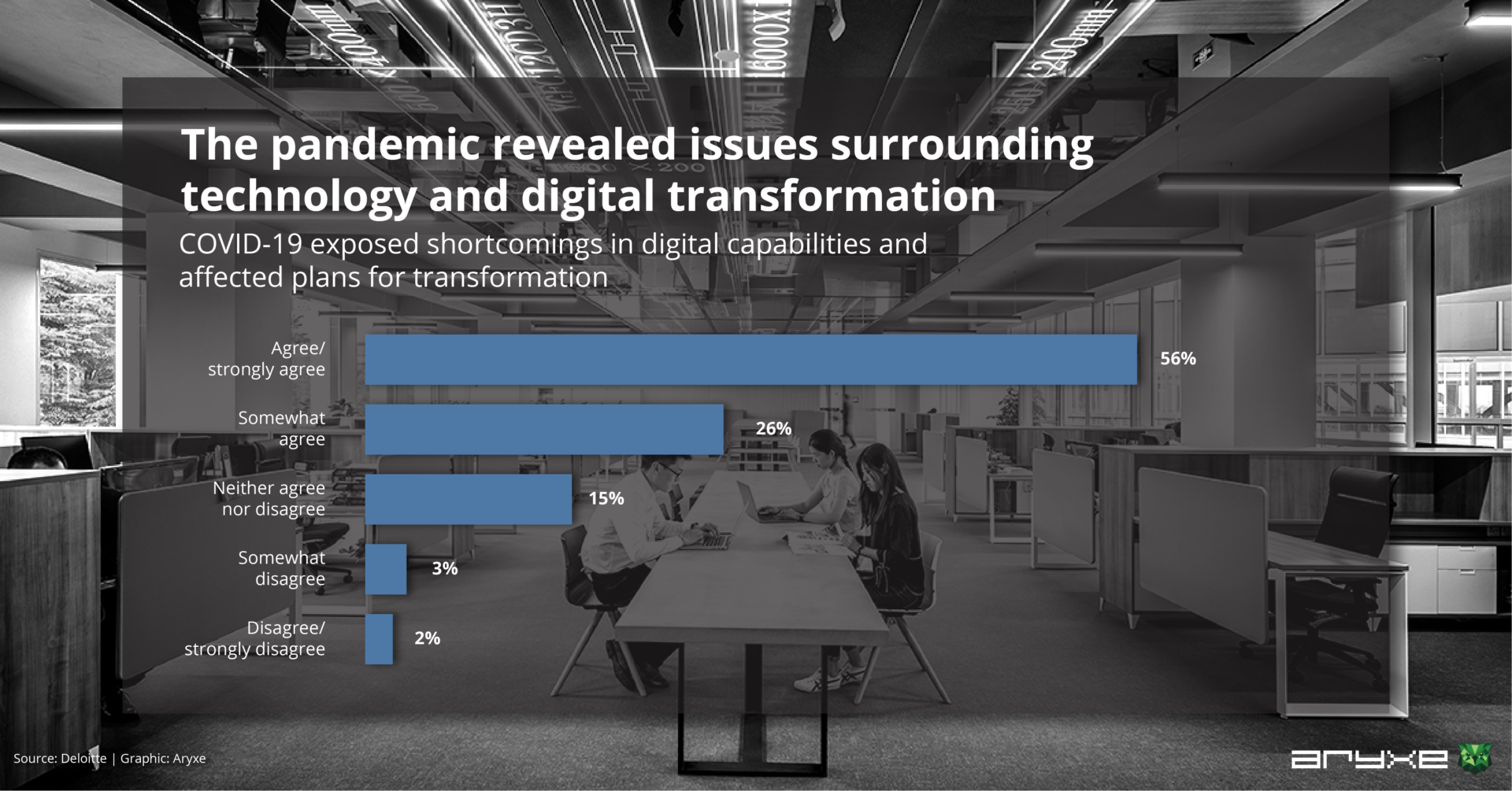
The pandemic shuttered thousands of restaurants, stores, and gyms worldwide. On top of that, it kept office workers away from the offices and also emptied hotel lobbies and rooms. Still, the commercial real estate market hasn’t had a reckoning quite that quickly, which is set to change.
In order to avoid fire sales, lenders have granted building owners months of forbearance. However, even as vaccines are slowly announcing a sluggish but almost certain return to what we call “the normal life”, it’s ever more clear that the fundamentals of real estate have been altered. This year will be tough on many property owners who have fallen behind on debt and they now have to put more money into their buildings, sell at ridiculous prices or hand the keys back to the bank. In the United States, roughly $430 billion in commercial and multifamily real estate debt matures this year, 2021. This will inevitably force lenders and borrowers to accept what buildings are actually worth in this world that has been reshaped by the coronavirus pandemic. The scale of damage has the potential to ripple far beyond just the building owners and their tenants. The tax base in cities depends on commercial properties to some extent and a CRE downturn would bring local budgets down with it. While loan losses are mounting, this slump will most probably put stress on the banking system as well.
CBRE Group Inc. suggests that property values for retail, apartments, and offices won’t bottom until late 2021. What’s worse is that they are projecting a slow rebound to start only in 2022 or even later. As we’ve shown earlier, too, logistics centers, warehouses, data centers, and industrial real estate will be exempt from this trend as they have actually gained value as investors snapped up buildings considered to be essential to the delivery economy.
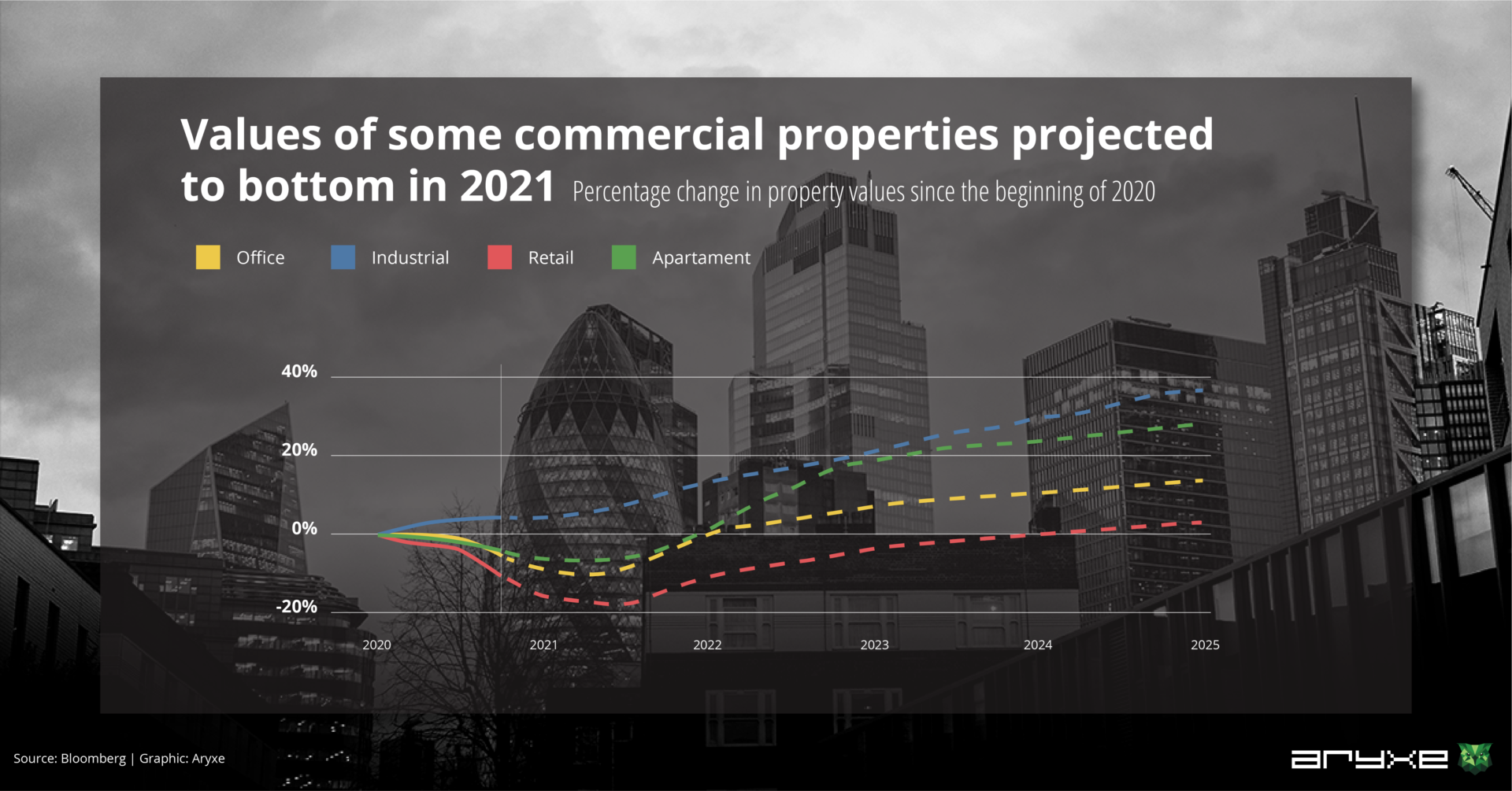
According to Green Street’s managing director, retail will keep being a hot mess, hospitality will have major challenges ahead and offices will be nothing short of problematic.
The screaming problem lays in the $529 billion markets for bonds backed by commercial real estate loans. The delinquency rate and all obligations will just become more difficult to repay as they fall further behind.
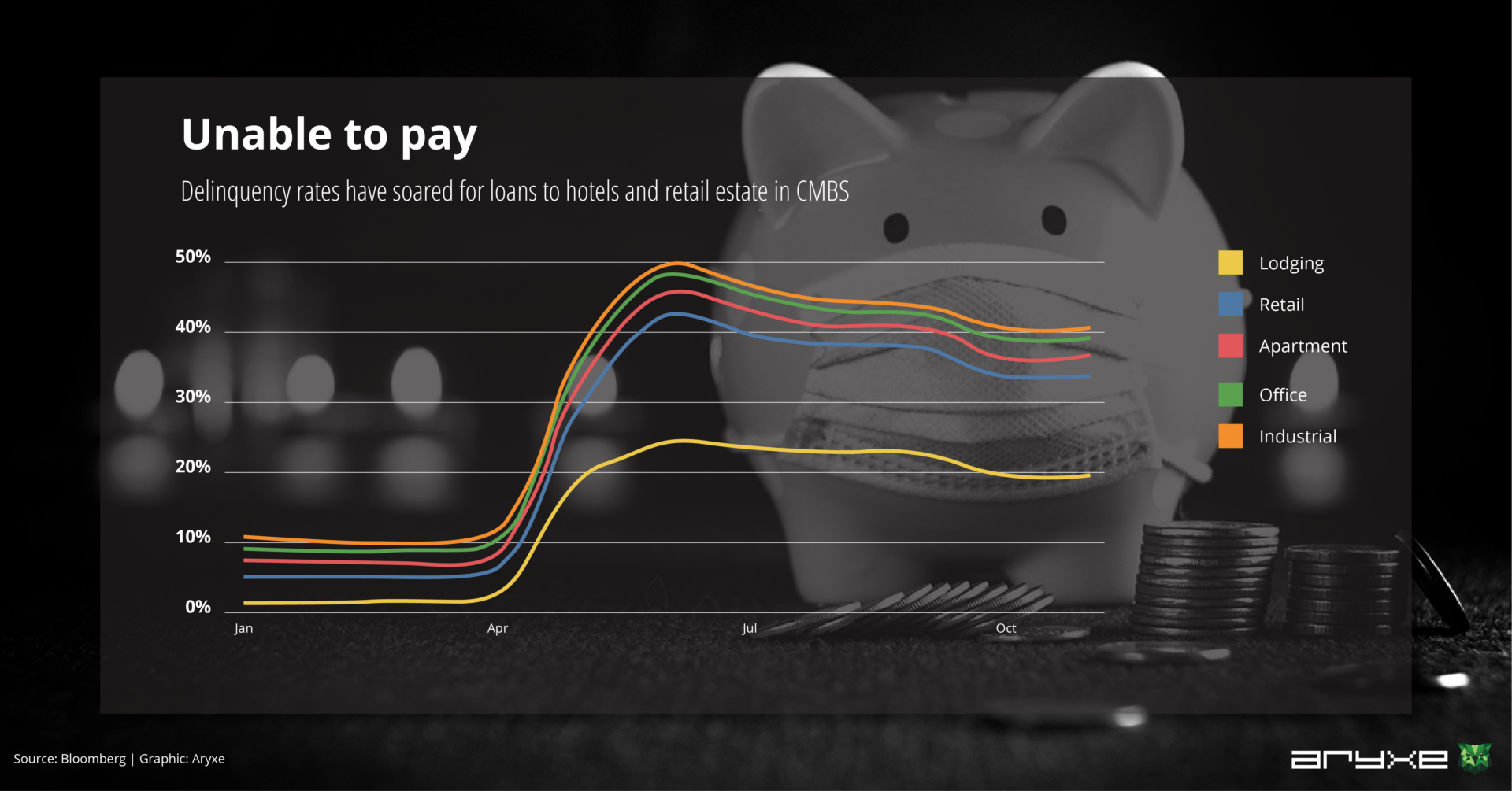
Office owners need to contend with higher vacancies as a large chunk of companies plan for a future marked by remote work. One of the examples is Deutsche Bank AG, still weighing a plan where their employees would adapt to a hybrid week of work, spending 2 days a week working from home and the rest from the office. Facebook on the other hand said that potentially they may be looking at half of its workforce going fully remote in the next decade.
There are some companies that are considering shifting their workforces elsewhere. Goldman Sachs Group Inc. for example, is pushing for relocation of part of its asset management from Wall Street to South Florida. Silicon Valley devotees such as Oracle Corp. and Hewlett Packard Enterprise Co. decided to make a move of their HQs to Texas.
At the moment, office use is looking like a fraction of what it once was. Still, office use is looking better in car-dependent cities like LA and Dallas than in places where people are more likely to use public transportation, such as San Francisco and New York.
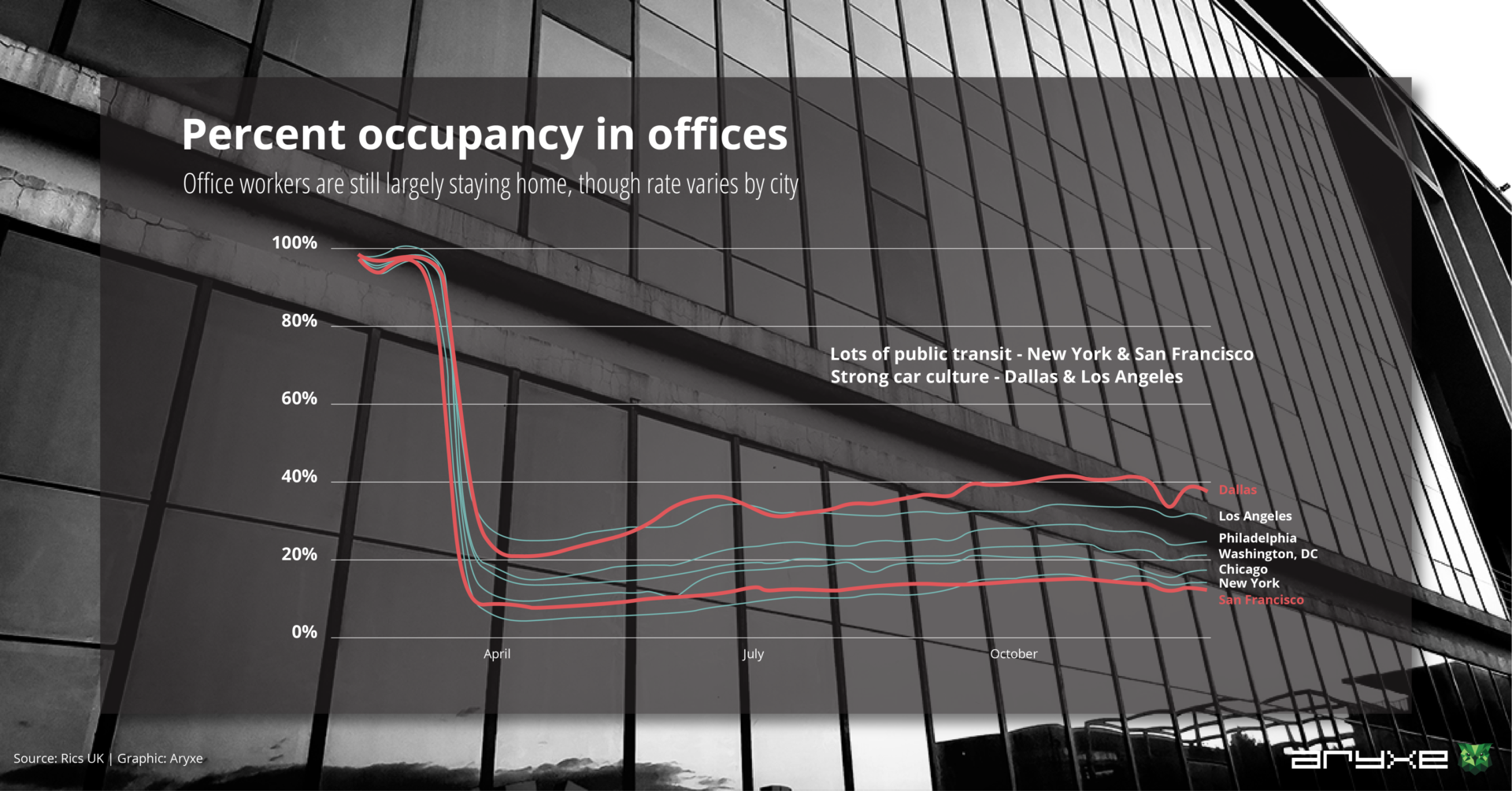
Even those borrowers who are keeping up with their payments now may end up facing challenges when their debt matures and they will need to refinance or pay off their principal. The so-called financial restructuring has already commenced, although behind the scenes.
The new lifelines come with stricter terms, often in the form of preferred equity or principal payments to reduce the loan-to-value ratio, he says.
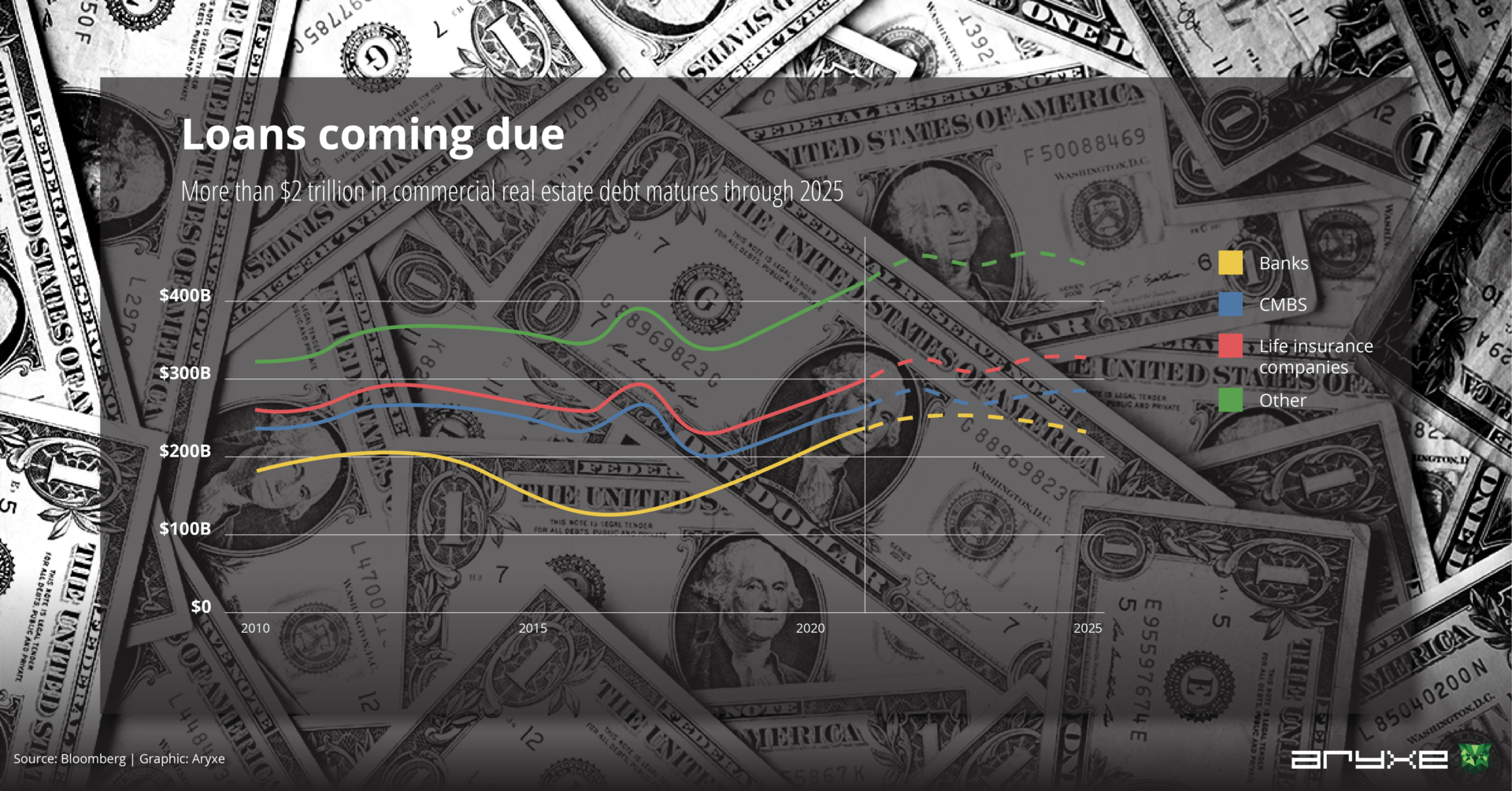
Long-term consequences have never been easy to predict, the immediate ones that have already shaken the market have been pretty clear and nothing short of dramatic. Most leaders need to work on establishing a balance between capital preservation and further strengthening of their differentiation from the competition – probably way easier said than done. Here’s what CRE leaders need to do in order to stay afloat:
Firstly, owners and operators must ensure they are protecting the safety and health of people by all means. Communication and even over-communication may be the key here. Tenants and space users will remember the effort and develop a trusting bond throughout the crisis, which will go a long way toward protecting value and relationships.
The real estate industry wasn’t really moving fast toward digitalization, not nearly as fast as other sectors. Some movements existed, depicted in the creation of digital services for tenants and users but being surprised by physical distancing, lockdowns and curfews led many to reconsider the importance of investing time and money into digitalization. Virtual open houses and showings are a thing now – using AR and VR can only help the process as it allows the visitors to get a sense of what a property looks and feels like without having to go and visit the place first.
The world has gone digital a long time ago. The pandemic only accelerated this shift and made it even more transparent. So, as more and more users adopt these digital-first products and services, their expectations will naturally start going up so the CRE leaders will need to stay ahead of the curve by providing a differentiated post-crisis experience using all the digital tools they can possibly get. It may seem like a costly strategy but these digital offerings are the ones that will end up paying dividends in the form of great loyalty while meeting the needs of both the tenants and the end-users.
It’s no news landlords was caught by surprise by the coronavirus pandemic so now most of them want to really engage in reevaluating their vision of the future and thinking ahead when it comes to the point of surpassing the crisis. Diving deep, head first, into strategic review processes with the goal of understanding how real estate usage might change going forward.
Most real estate leaders have been smart about this and have already started making decisions that protect the safety and health of all their employees, tenants, and end-users of their space. Ones that are even smarter are rethinking the real estate landscape and trying to figure out how it may be changed permanently and how this will impact their strategy.
CRE leaders that manage to be successful in strengthening their position during the coronavirus crisis will do more than just adapt, they will take numerous bold actions and make thousands of important decisions that will further deepen the relationships with investors, end-users, employees, and all stakeholders.
Will people be willing to go back to their pre-pandemic routines in their entirety? Well, people are getting tired of socializing over their screens and are more than eager to gather in person with their loved ones. There’s a tangible craving for in-person contact. So, while it is true that some people adapted quite effortlessly to the work from home lifestyle, with the convenience of online shopping and virtual parties, it’s difficult to say offices, retail spaces and hotels are dead.
Some executives may cut back on their business travel and some families may end up moving to suburban homes rather than a flat downtown they wanted solely because of the vicinity to their office. Still, we shouldn’t be jumping to conclusions and saying that the cities will never ever be the same. There is a place for offices, retail stores, and hospitality in the post-pandemic world, too. Cities will bounce back thanks to the people who miss the in-person contact and the lifestyle that urban centers offer.
Lenders are still on the lookout for good quality real estate, that has not changed for sure. While much capital sat on the sidelines in 2020, lenders are still very much interested in financing deals with strong, long-term value. The only thing that has changed here is the understanding of a good quality property, simply because what has once been a good quality property will be slightly different in the post-pandemic world so they will need to figure out how to attract lenders’ attention and earn some trust right off the bat.
https://www.bloomberg.com/graphics/2020-commercial-real-estate/
https://www.fieldfisher.com/en/insights/dealing-with-the-impact-of-covid-19-in-the-commerc
https://www.cnbc.com/2020/09/27/office-real-estate-back-to-normal-in-2025-cushman-wakefield.html
https://www.wsp.com/en-GL/insights/how-will-covid-19-change-demand-for-office-space
You are currently viewing a placeholder content from Default. To access the actual content, click the button below. Please note that doing so will share data with third-party providers.
More InformationInput your email to get the latest news in your inbox. We promise not to spam.